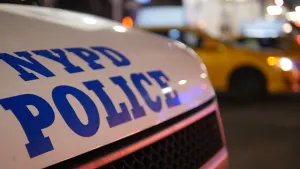Kobe Bryant crash pilot disoriented in clouds, safety investigators say
Safety investigators say the pilot of Kobe Bryant’s helicopter flew through the clouds in an apparent violation of federal standards, and likely became disoriented.
Share:
More Stories
0:20

Poll shows most Americans want Super Bowl moved to Presidents' Day weekend
yesterday0:24

Nick Mangold, popular All-Pro Jets center, dies from kidney disease
3ds ago1:45

Ex-Knick Chauncey Billups, Heat's Rozier among dozens arrested in gambling probe tied to Mafia
6ds ago
Yankees fall to Toronto Blue Jays in Game 4 of American League Division Series
20ds ago
Judge rallies Yankees past Blue Jays 9-6 to save season and avert ALDS sweep
21ds ago1:46

Resident concerns mount over rundown conditions at Macombs Dam Park
22ds ago0:20

Poll shows most Americans want Super Bowl moved to Presidents' Day weekend
yesterday0:24

Nick Mangold, popular All-Pro Jets center, dies from kidney disease
3ds ago1:45

Ex-Knick Chauncey Billups, Heat's Rozier among dozens arrested in gambling probe tied to Mafia
6ds ago
Yankees fall to Toronto Blue Jays in Game 4 of American League Division Series
20ds ago
Judge rallies Yankees past Blue Jays 9-6 to save season and avert ALDS sweep
21ds ago1:46

Resident concerns mount over rundown conditions at Macombs Dam Park
22ds agoU.S. safety investigators said Tuesday the pilot of Kobe Bryant’s helicopter flew through the clouds last year in an apparent violation of federal standards, and likely became disoriented just before the helicopter crashed and killed Bryant and eight others.
Robert Sumwalt, chairman of the National Transportation Safety Board, said that pilot Ara Zobayan was flying under visual flight rules, which meant that he needed to be able to see where he was going.
Zobayan piloted the aircraft to climb sharply and had nearly broken through the clouds when the Sikorsky S-76 helicopter banked abruptly and plunged into the Southern California hills below, killing all aboard.
The helicopter did not have the so-called “black box” recording devices, which were not required.
The revelation during a hearing to announce the probable cause or causes of the crash followed plenty of finger-pointing.
Bryant’s widow blamed the pilot. She and relatives of the other victims also faulted the companies that owned and operated the helicopter.
The brother of the pilot didn’t blame Bryant but said he knew about the risks of flying. The helicopter companies said foggy weather before the helicopter hit the ground was an act of God and blamed air traffic controllers.
The federal hearing focused on the long-awaited probable cause or causes of the tragedy that unleashed worldwide grief for the retired basketball star, launched several lawsuits and prompted state and federal legislation.
“I think the whole world is watching because it’s Kobe,” said Ed Coleman, an Embry-Riddle Aeronautical University professor and aircraft safety science expert.
Bryant, his 13-year-old daughter, Gianna, and six other passengers were flying from Orange County to a youth basketball tournament at his Mamba Sports Academy in Ventura County on Jan. 26, 2020, when the helicopter encountered thick fog in the San Fernando Valley north of Los Angeles.
Pilot Ara Zobayan climbed sharply and nearly broke through the clouds when the Sikorsky S-76 helicopter banked abruptly and plunged into the Calabasas hills below, killing all nine aboard instantly before flames engulfed the wreckage.
There was no sign of mechanical failure and the crash was believed to be an accident, the National Transportation Safety Board has said previously.
The board on Tuesday is likely to make nonbinding recommendations to prevent future crashes when it meets remotely and announces its findings about the crash.
The NTSB is an independent federal agency that investigates transportation-related crashes but has no enforcement powers.
It submits suggestions to agencies like the Federal Aviation Administration or the Coast Guard, which have repeatedly rejected some board safety recommendations after other disasters.
One possible recommendation following the investigation into the crash that killed Bryant could be for helicopters to have Terrain Awareness and Warning Systems, devices that signal when aircraft are in danger of crashing.
The helicopter Bryant was flying in did not have the system, which the NTSB has recommended as mandatory for helicopters. The FAA requires it only for air ambulances.
Federal lawmakers have sponsored the Kobe Bryant and Gianna Bryant Helicopter Safety Act to mandate the devices on all helicopters carrying six or more passengers.
Former NTSB Chairman James Hall said he hopes the FAA will require the systems as a result of the crash.
“Historically, it has required high-profile tragedies to move the regulatory needle forward,” he said.
The devices, known as TAWS, cost upward of $35,000 per helicopter and require training and maintenance.
Helicopter Association International, which represents the helicopter industry, discouraged what it called a “one solution fits all” method.
President and CEO James Viola said in a statement that mandating specific equipment for the entire industry would be “ineffective” and “potentially hazardous.”
Even though Zobayan was flying at low altitude in a hilly area, the warning system may not have prevented the crash, Coleman said.
The rugged terrain could have triggered the alarm "constantly going off” and distracted the pilot or prompted him to lower the alarm's volume or ignore it, the Embry-Riddle safety science professor said.
Federal investigators said Zobayan, an experienced pilot who often flew Bryant, may have “misperceived” the angles at which he was descending and banking, which can occur when pilots become disoriented in low visibility, according to NTSB documents.
The others killed in the crash were Orange Coast College baseball coach John Altobelli, his wife, Keri, and their daughter Alyssa; Christina Mauser, who helped Bryant coach his daughter’s basketball team; and Sarah Chester and her daughter Payton. Alyssa and Payton were Gianna’s teammates.
The crash has generated lawsuits and countersuits.
On the day that a massive memorial service was held at the Staples Center, where Bryant played most of his career, Vanessa Bryant sued Zobayan and the companies that owned and operated the helicopter for alleged negligence and the wrongful deaths of her husband and daughter. Families of other victims sued the helicopter companies but not the pilot.
Vanessa Bryant said Island Express Helicopters Inc., which operated the aircraft, and its owner, Island Express Holding Corp., did not properly train or supervise Zobayan. She said the pilot was careless and negligent to fly in fog and should have aborted the flight.
Zobayan’s brother, Berge Zobayan, has said Kobe Bryant knew the risks of flying in a helicopter and that his survivors aren’t entitled to damages from the pilot’s estate. Island Express Helicopters Inc. denied responsibility and said the crash was “an act of God” that it could not control.
The company also countersued two FAA air traffic controllers, saying the crash was caused by their “series of erroneous acts and/or omissions.”
The countersuit claims one controller improperly denied Zobayan’s request for “flight following,” or radar assistance, as he proceeded in the fog. Officials have said the controller terminated service because radar could not be maintained at the altitude the aircraft was flying.
According to the lawsuit, the controller said he was going to lose radar and communications shortly, but radar contact was not lost.
When a second controller took over, the lawsuit said, the first controller failed to brief him about the helicopter, and because the radar services were not terminated correctly, the pilot believed he was being tracked.
Vanessa Bryant also sued the Los Angeles County Sheriff’s Department, accusing deputies of sharing unauthorized photos of the crash site. California now has a state law prohibiting such conduct.
More from News 12
1:45

Bronx foundation collecting donations to help Jamaica rebuild after Hurricane Melissa
2:01

Bronx community growing fearful amid cuts to SNAP benefits

Father stabbed 12-year-old step-daughter with various kitchen utensils, court documents reveal
0:26

60-year-old man robbed at gunpoint in Belmont
2:30

Surprising endorsement: United Bodegas of America endorses Zohran Mamdani for NYC mayor
0:22
